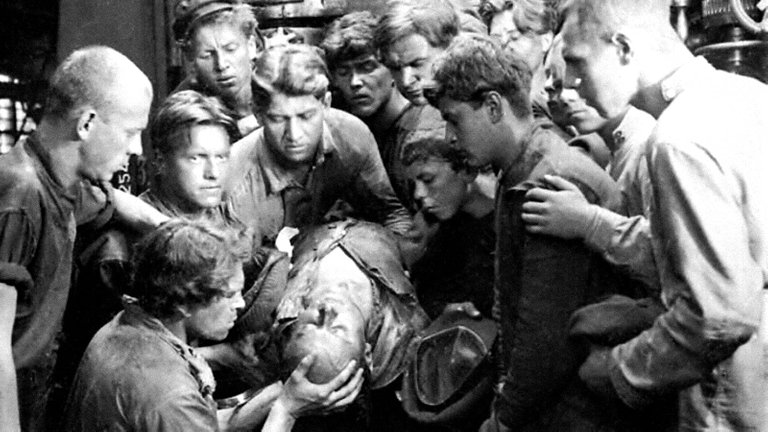Film Review: Strike (Stachka, 1925)

Battleship Potemkin by Sergei Eiseinstein is the most important and the most influential film of the silent era. Eisenstein didn’t create it out of the thin air. It was result of years of careful studying of the emerging cinema art and adoption of avant-garde art, literature and theatre that thrived in the first decade of post-revolutionary Soviet Russia. Eisenstein formulated some of its views in its own set of film theory, published as an article titled “The Montage of Attractions”. It was first put into practice shortly before Battleship Potemkin, in Eisenstein’s feature debut – period drama Strike, which served both as dress rehearsal and companion piece to his best known film.
Strike, like Battleship Potemkin, was originally envisioned as part of much larger and ambitious project dealing with recent pre-revolutionary past through prism of official Soviet ideology. It was “Towards Dictatorship (of the Proletariat)”, cycle of six films chronicling the rise of labour movement in Russia until its triumph in October Revolution. Eisenstein managed to finish only the first part. The plot is set in unnamed Russian factory at the very beginning of 20th Century. There is a palpable tension between workers and management, with workers becoming increasingly open to agitation by members of Russian Social Democrat Party (Bolsheviks). This is cause of concern for Okhrana, Czarist secret police, which recruits set of colourful characters to serve as spies and provocateurs. When Yakov Strongin (played by Mikhail Gomorov) gets falsely accused by management of stealing factory equipment and denied three weeks of pay, he hangs himself. This infuriates his comrades which decide to take stop working and take over the factory. They demand 8-hour work day, 30 percent rise in wages and 6-hour work for minors, but the owners refuse. Instead, Okhrana hires group of street thugs to infiltrate striking workers’ ranks and set fire to a liquor store, which is an excuse for authorities to send firemen that would disperse striking crowd with water hoses. The violence is further excuse for intervention of army that would crush the strike by massacring large number people, including innocent women and children.
Inevitable comparisons between Strike and Potemkin would, predictably, be in favour of the latter. Eisenstein was still learning the proper film making craft in his first film, but the his talent is still here to see, as well as various techniques he would employ in his latter films. The most obvious is suggestive and very rapid editing that uses contrasting images to create strong emotional response, very much like those that would decades later be enthusiastically embraced by creators of MTV videos. This technique is used most famously at the very end, when the images of strikers being killed by police and military is intercut with the scenes of animals being slaughtered; Francis Ford Coppola half a century later paid homage to that scene in the similar ending of Apocalypse Now.
Eisenstein tried to stir emotional reaction among audience for propaganda purposes. And propaganda in Strike completely lacks any subtlety. The film lacks conventional protagonists and, in accordance with the ideology that puts collective over individuals, all characters are minor and part of larger whole. They are clearly identified as part of two warring classes – workers, who live simple life and try to feed and give decent life to their families; and, grotesquely obese and decadent capitalists, aided by arrogant police bureaucrats and amoral lumpenproletariat. Film nevertheless features some more than decent acting, although Eiseinstein’s skill is more evident in staging of complicated mass scenes.
Strike, unlike Battleship Potemkin, wasn’t much of a success at the box office. This could be explained with fictional, and somewhat banal story, being less attractive than armed takeover of a battleship, as well as the rather depressive ending (with Eisenstein obviously believing that the last and never made part of his cycle, dealing with October Revolution would provide happy ending). Film was nevertheless liked by the critics, but, unlike Battleship Potemkin wasn’t shown much outside Soviet Union and became object of interest among film historians only decades later. However, those who watch it today, even if they don’t disregard its technical and ideological limitations, would nevertheless recognise powerful piece of cinema that served as foundations for many later films we know take for granted as masterpieces.
RATING: 7/10 (+++)
Blog in Croatian https://draxblog.com
Blog in English https://draxreview.wordpress.com/
Leofinance blog https://leofinance.io/@drax.leo
Unstoppable Domains: https://unstoppabledomains.com/?ref=3fc23fc42c1b417
Hiveonboard: https://hiveonboard.com?ref=drax
Bitcoin Lightning HIVE donations: https://v4v.app/v1/lnurlp/qrcode/drax
Rising Star game: https://www.risingstargame.com?referrer=drax
1Inch: https://1inch.exchange/#/r/0x83823d8CCB74F828148258BB4457642124b1328e
BTC donations: 1EWxiMiP6iiG9rger3NuUSd6HByaxQWafG
ETH donations: 0xB305F144323b99e6f8b1d66f5D7DE78B498C32A7

I wonder how you were able to get to watch a movie of 1925. That has been for so long. Nice review!!!